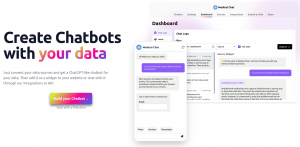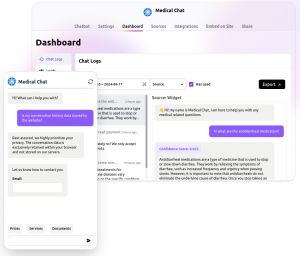
Implementa real-time voice-to-voice AI chatbot based on your knowledge base
Build a real-time voice-to-voice AI chatbot using a Voiced RAG flow to answer questions based on your knowledge base.
SAN FRANCISCO, CA, UNITED STATES, October 29, 2024 /EINPresswire.com/ -- In today’s digital landscape, real-time interactions are increasingly vital for modern applications, as they enable instant user engagement and enhance overall experience. OpenAI's Realtime API serves as a key enabler in this domain, facilitating seamless, low-latency communication that allows interactions to feel more natural and fluid. Integrating Advanced ChatGPT Voice capabilities with this API provides applications with dynamic, engaging responses, transforming user interaction with AI.
Real-Time API Benefits for Chat Data Users
Increased Accessibility
A voice-to-voice AI chatbot broadens accessibility, especially for users who prefer speaking or face challenges with typing. It’s valuable for individuals with visual impairments or mobility limitations, creating a more inclusive, user-friendly experience.
Personalized Interactions
Real-time voice AI detects nuances in tone and emotion, enabling responses to adjust dynamically. This fosters personalized, empathetic interactions, enhancing rapport and customer satisfaction.
Faster Problem Resolution
Immediate responses through real-time voice interaction allow for quicker query resolution, eliminating delays associated with text-based communication. This proves especially advantageous in support scenarios, where swift issue resolution boosts satisfaction.
Multitasking Convenience
Voice-to-voice interaction enables hands-free engagement, ideal in scenarios where typing isn’t practical, such as while driving or cooking. This added convenience broadens the chatbot’s utility.
Increased Productivity
In business settings, real-time voice AI can handle repetitive or simple requests, allowing human agents to focus on complex tasks. This optimizes productivity and resource allocation for support teams.
Brand Differentiation
Advanced real-time voice capabilities distinguish platforms in a competitive market. As voice AI gains popularity, early adopters achieve a competitive edge by offering an innovative, interactive experience.
Building a Real-Time Voice-to-Voice AI Chatbot Based on a Knowledge Base
For those with technical expertise, it is possible to create a voice-to-voice AI chatbot using the GPT-4 Realtime API in conjunction with Azure’s OpenAI. Detailed guidance is available in the article “Create Your Own Realtime Voice-to-Voice AI Chatbot with Code Examples,” which outlines how Chat Data developed its voice AI assistant with a customized knowledge base.
Alternatively, Chat Data offers services that allow creation of a real-time voice-to-voice chatbot without any coding. By uploading training data, Chat Data can transform content into a professional AI chatbot capable of answering questions based on a specified knowledge base. Enabling the Realtime Audio feature provides voice-to-voice interaction, following the Realtime Voice Chat documentation.
Some use cases that can benefit from a real-time voice-to-voice AI chatbot include:
Customer Service for Hands-Free Support
A voice-to-voice AI chatbot enables customers to resolve issues hands-free, ideal in scenarios like driving or cooking. This approach offers faster response times, more natural interactions, and broader accessibility.
Technical Support with Verbal Guidance
For technical troubleshooting, a voice-based AI chatbot provides step-by-step guidance in a conversational manner, allowing users to follow instructions clearly.
Personalized Sales and Product Recommendations
A voice-to-voice chatbot enhances product recommendations, providing a conversational experience where users can receive tailored feedback based on their preferences.
Healthcare Assistance for Accessibility
In healthcare, a voice-to-voice chatbot supports elderly patients or those with limited technical literacy, offering information through a friendly voice interface to improve access and comfort.
Travel Assistance for On-the-Go Navigation
For travelers, a voice-based chatbot facilitates hands-free interaction, ideal for inquiring about directions, booking details, or local recommendations while on the move.
Enhanced Learning Support for Students
A voice-based chatbot supports students, especially auditory learners, by adapting responses to comprehension levels, making it an effective educational tool.
Crisis Response for Real-Time Guidance
In emergencies, a voice-to-voice AI chatbot delivers immediate guidance, helping users stay calm and make informed decisions under stress.
To build an voice realtime chatbot with Chat Data, you can follow the following steps
Set Up Realtime Voice Chat
The Realtime Voice Chat feature requires activation, as it involves substantial resource usage. To enable it, follow these steps:
1. Access Realtime Audio Settings: Go to the Settings page and open the Realtime Audio tab.
2. Configure Voice Avatar: Set the voice avatar that will display in the chatbot widget's center for a personalized experience.
3. Select a Default Voice: Choose a default voice to initiate user interactions. Users will have the option to change this if desired.
4. Preview Voices: Use the play button to listen to voice samples before selecting.
Realtime Voice Chat Settings
The Realtime Voice Chat settings provide options for recording and playback. By default, the Enable Record Audio feature is active, allowing original voice interactions to be reviewed in the chat logs dashboard. If disabled, only transcripts created by OpenAI’s Whisper model will be available, though slight variations may occur between the transcript and OpenAI’s real-time API’s interpreted audio.
All recorded interactions are stored securely in encrypted Azure Blob Storage and count toward the file storage quota. The Standard plan includes 2.5 GB of storage, and the Professional plan offers 10 GB.
Key adjustable parameters for realtime voice chat include:
Threshold: Sets voice activity detection sensitivity (lower values increase sensitivity).
1. Prefix Padding: Controls the duration of audio included before speech recognition starts.
2. Silence Duration: Determines the silent period before the system concludes speech has ended.
3. RAG Limit: Limits the number of search results added to context. Fewer results help to reduce input token usage.
Users can modify the chatbot's voice by selecting the “Adjust” button in the top-right corner, which opens the voice selection overlay. Language options can also be customized through the settings.
Summary
Chat Data’s real-time voice-to-voice AI chatbot provides a powerful solution for natural, instant user interactions. With its applications across diverse fields—from technical support and healthcare to retail and travel—the chatbot enables hands-free support, personalized guidance, and real-time assistance. The solution allows organizations to transform knowledge bases into an advanced AI chatbot that engages users instantly, enhancing accessibility and user satisfaction without requiring any coding.
Emma Ke
Chat Data
+1 608-616-0209
email us here
Visit us on social media:
X
LinkedIn
YouTube
Create your own realtime voice AI chatbot with your data through Voice RAG
Distribution channels: Companies, Media, Advertising & PR, Social Media, Technology, Telecommunications
Legal Disclaimer:
EIN Presswire provides this news content "as is" without warranty of any kind. We do not accept any responsibility or liability for the accuracy, content, images, videos, licenses, completeness, legality, or reliability of the information contained in this article. If you have any complaints or copyright issues related to this article, kindly contact the author above.
Submit your press release

